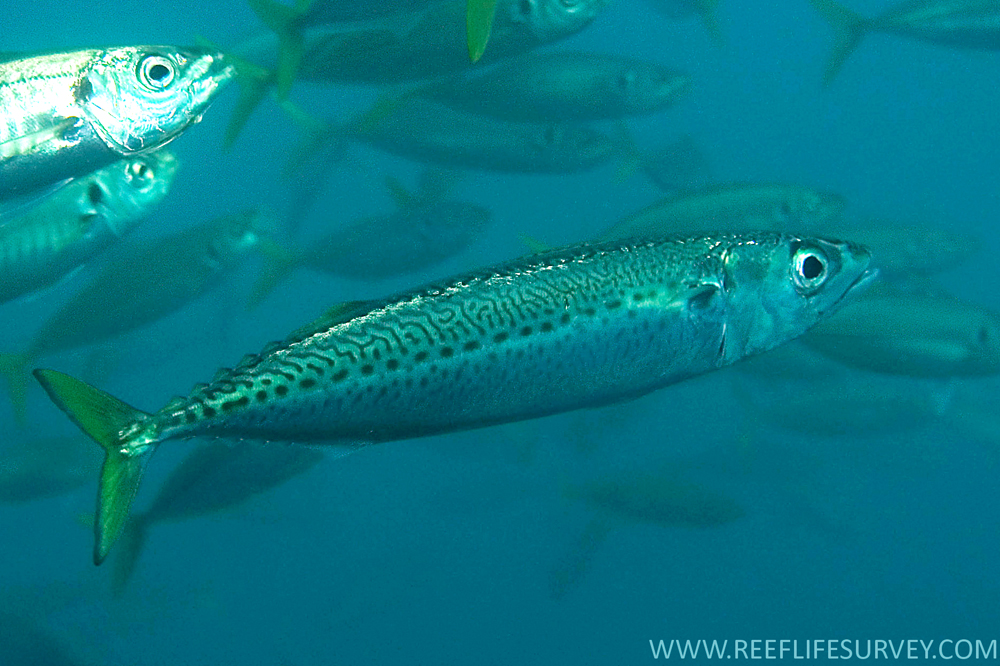- Classification
- ACTINOPTERYGII
- PERCIFORMES
- SCOMBRIDAE
- Scomber
- australasicus
Blue Mackerel, Scomber australasicus Cuvier 1832

A Blue Mackerel, Scomber australasicus. Source: Andrew J. Green / Reef Life Survey. License: CC BY Attribution
A small mackerel species that schools in large numbers, and is often used as bait by recreational fishers in central and southern New South Wales.
The species is bluish to greenish above, pearly white below, with narrow diagonal zigzag and reticulated lines on the upper sides, spots along the midside, and fine wavy broken lines below. The dark reticulated pattern become less distinct as the fish ages.
Blue Mackerel, Scomber australasicus Cuvier 1832
More Info
|
Distribution |
Found in the waters of all Australian states, but absent from the Gulf of Carpentaria and Cape York. Known elsewhere from tropical and temperate waters of the Pacific and Indian oceans. An epipelagic, neritic species found inshore, and in the open ocean to a depth of 200 m. Blue Mackerel are relatively uncommon in tropical waters. |
|
Features |
Dorsal fin X-XIII, 0, 0, 12; Anal fin 1,12; Pectoral fin 18-21; Gill rakers 25-35. Body fusiform body with two widely separated dorsal fins; snout pointed; eyes with adipose eyelids that leave a vertical slit over the pupils; jaws with small conical teeth. Second dorsal and anal fins followed by five to six finlets; pectoral fin short; anal-fin origin clearly more posterior than that of second dorsal fin origin; anal-fin spine separated from rest of anal fin; interpelvic process small, single. Body covered in small scales, corselet absent. Caudal peduncle with two small keels, but no large lateral keel. Swim bladder absent. |
|
Size |
To 40 cm. |
|
Colour |
Blue dorsally, lower sides and belly silver yellow. Dark wavy lines dorsally, belly marked with wavy, broken lines, sometimes with dusky blotches. |
|
Feeding |
Carnivore - feeds on zooplankton such as copepods and other crustaceans; adults also consume small fishes and squids. |
|
Biology |
A serial spawner that spawns along the southern coast during the summer months, and may spawn year-round along the east coast. Individuals can live to an age of 7 years. The Blue Mackerel forms large schools consisting of a mixture of year classes. |
|
Fisheries |
The commercial fishery in Eastern Australia comprises mainly younger fish, in the 2-3 year age group. Also fished commercially in Tasmania. Recreational fishers are estimated to match commercial catches in New South Wales, using the fish mainly for bait. The species is used both as food for humans and as bait for other fish, and is an important food source for large pelagic fishes such as tunas, as well as for marine mammals such as dolphins and sea lions. |
|
Remarks |
|
|
Etymology |
The specific name australasicus is from Latin in reference to its southern distribution. |
|
Species Citation |
Scomber australasicus Cuvier 1832, Historie naturelle des poissons. 8: 49, King George Sound, Western Australia. |
|
Author |
Schultz, S. |
Blue Mackerel, Scomber australasicus Cuvier 1832
References
Baker, E.A. & B.B. Collette. 1998. Mackerel from the northern Indian Ocean and the Red Sea are Scomber australasicus, not Scomber japonicus. Ichthyol. Res. 45: 29-33.
Collette, B., Acero, A., Canales Ramirez, C., Cardenas, G., Carpenter, K.E., Chang, S.-K., Chiang, W., Di Natale, A., Fox, W., Guzman-Mora, A., Juan Jorda, M., Miyabe, N., Montano Cruz, R., Nelson, R., Salas, E., Schaefer, K., Serra, R., Sun, C., Uozumi, Y., Wang, S., Wu, J., Yanez, E. & Yeh, S. 2011. Scomber australasicus. The IUCN Red List of Threatened Species 2011: e.T170329A6750490. . Downloaded on 21 September 2015.
Carpenter, K.E. & Niem, V.H. (eds). FAO species identification guide for fishery purposes. The living marine resources of the Western Central Pacific. Volume 6. Bony fishes part 4 (Labridae to Latimeriidae), estuarine crocodiles, sea turtles, sea snakes and marine mammals. Rome, FAO. 2001. pp. 3381-4218.
Collette, B.B. and C.E. Nauen, FAO species 1983, catalogue. Vol. 2. Scombrids of the world. An annotated and illustrated catalogue of tunas, mackerels, bonitos and related species known to date. FAO Fish. Synop., (125) Vol. 2: 137 pp.









